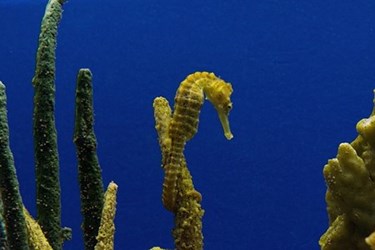Hip To Be Square: Seahorse Tails Could Inspire Surgical Robots

The quirks of evolution have given seahorses a square-shaped tail, which is effective when grasping coral or fending off predators. Now, scientists are now looking for ways to apply time-tested biomechanics to modern day robotics, and they believe the square-tailed seahorse could inspire stronger, more flexible, and more durable biomedical tools.
The seahorse’s tail consists of 36 square-shaped segments, each consisting of 4 “L” shaped plates that taper in size toward the bottom. A square tail is a rare find in the animal kingdom, as most animal tails are cylindrical, and this got scientists thinking about the possible advantages a square tail would offer the sea-dwelling creature.
“When living organisms deviate from the norm, there’s usually a good biomechanical reason: a clue to some specific problem that needs to be solved,” Miriam Ashley Ross, a biology professor at Wake Forest College who was not involved with the study, told the Los Angeles Times.
The research began at the University of California, San Diego with the design of a steerable catheter. Michael Porter, now a mechanical engineer at Clemson University, first designed the catheter to be square-shaped like the seahorse, but thought a round shape would be better suited for veins. To his surprise, Porter found the round version of his design did not work nearly as well as the square one.
Porter’s impressions from the catheter project led him to study how a square shape could make a better device and, to prove his theories, Porter and a team at Clemson 3D printed two sea horse models: one made with box-like plates, and the other with rounded, crescent-shaped plates.
In a study published in Science, the researchers reported that the square design retained its shape when compressed because the squares slid neatly over each other, while the crescents kinked up and warped the shape of the model. The team believes that their findings will prove useful for engineers seeking to maintain device flexibility without sacrificing durability.
Ross Hatton, a co-author of the study, told Business Standard that the innovation could prove useful in devices that perform laparoscopic procedures, because it would be flexible enough to stretch around organs, but stiff enough to accomplish the surgery.
“This could be very useful for robotics applications that need to be strong, but also energy-efficient and able to bend and twist in tight places,” Hatton said.
Many scientists are looking for solutions to modern human challenges by studying time-tested patterns that occur in the natural world.
According to Porter, in a press release from UC San Diego’s Jacobs School of Engineering, “The study of natural materials can lead to the creation of new and unique materials and structures inspired by nature that are stronger, tougher, lighter and more flexible.”
Using biomimicry to innovate, recent research also has developed surgical arms based on octopus anatomy and artificial tissue growth using principles of the cuttlefish.
